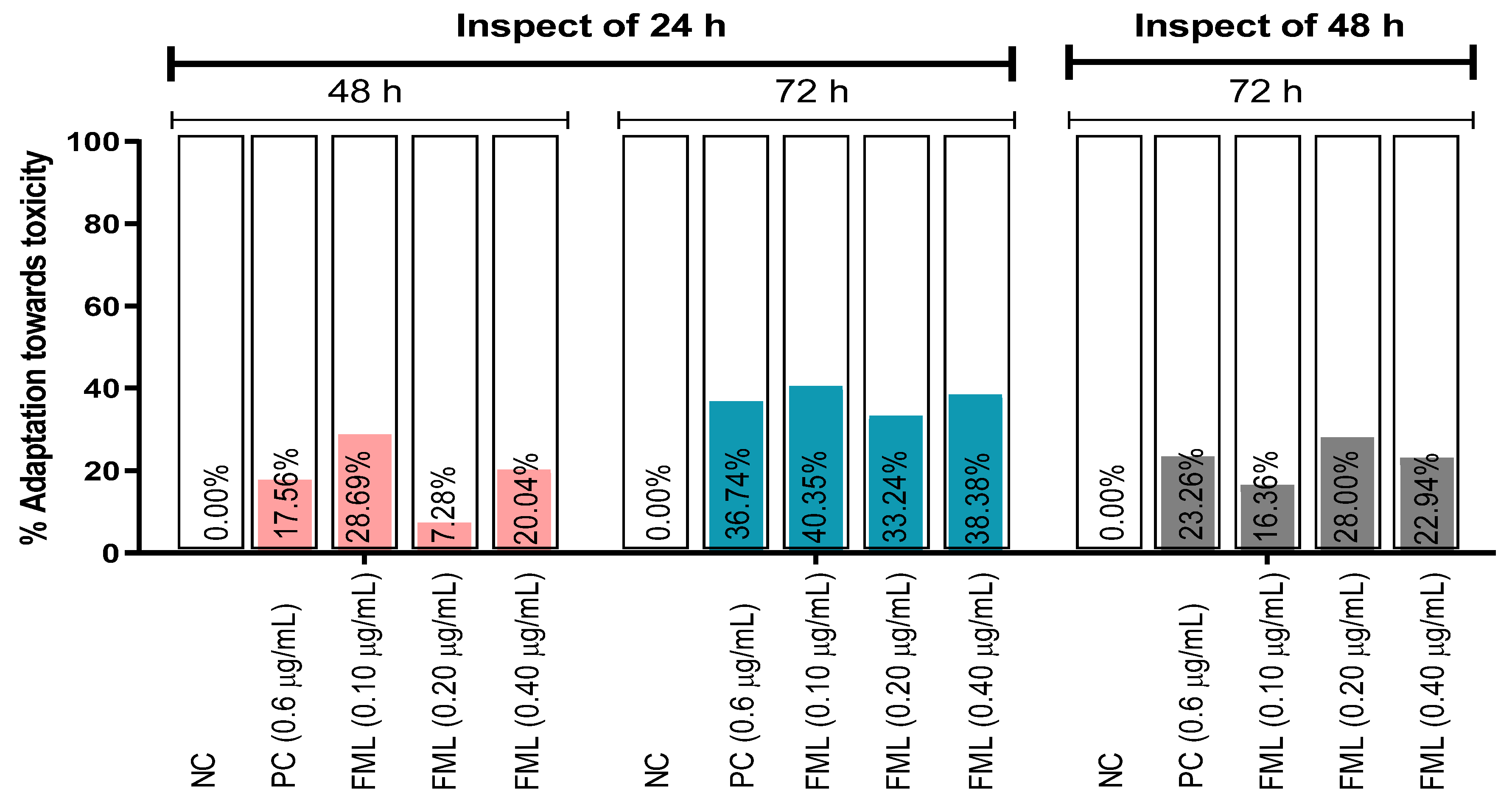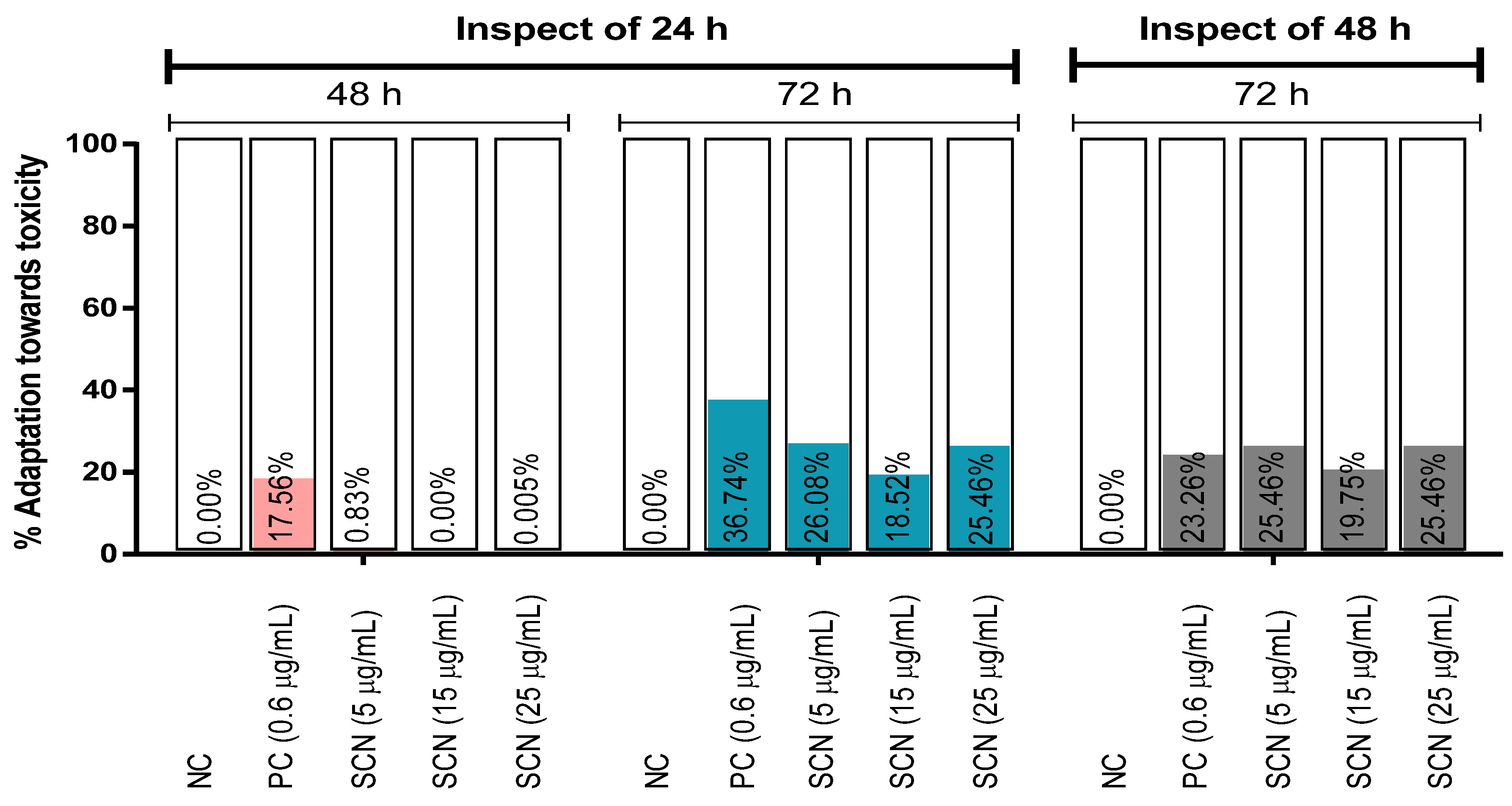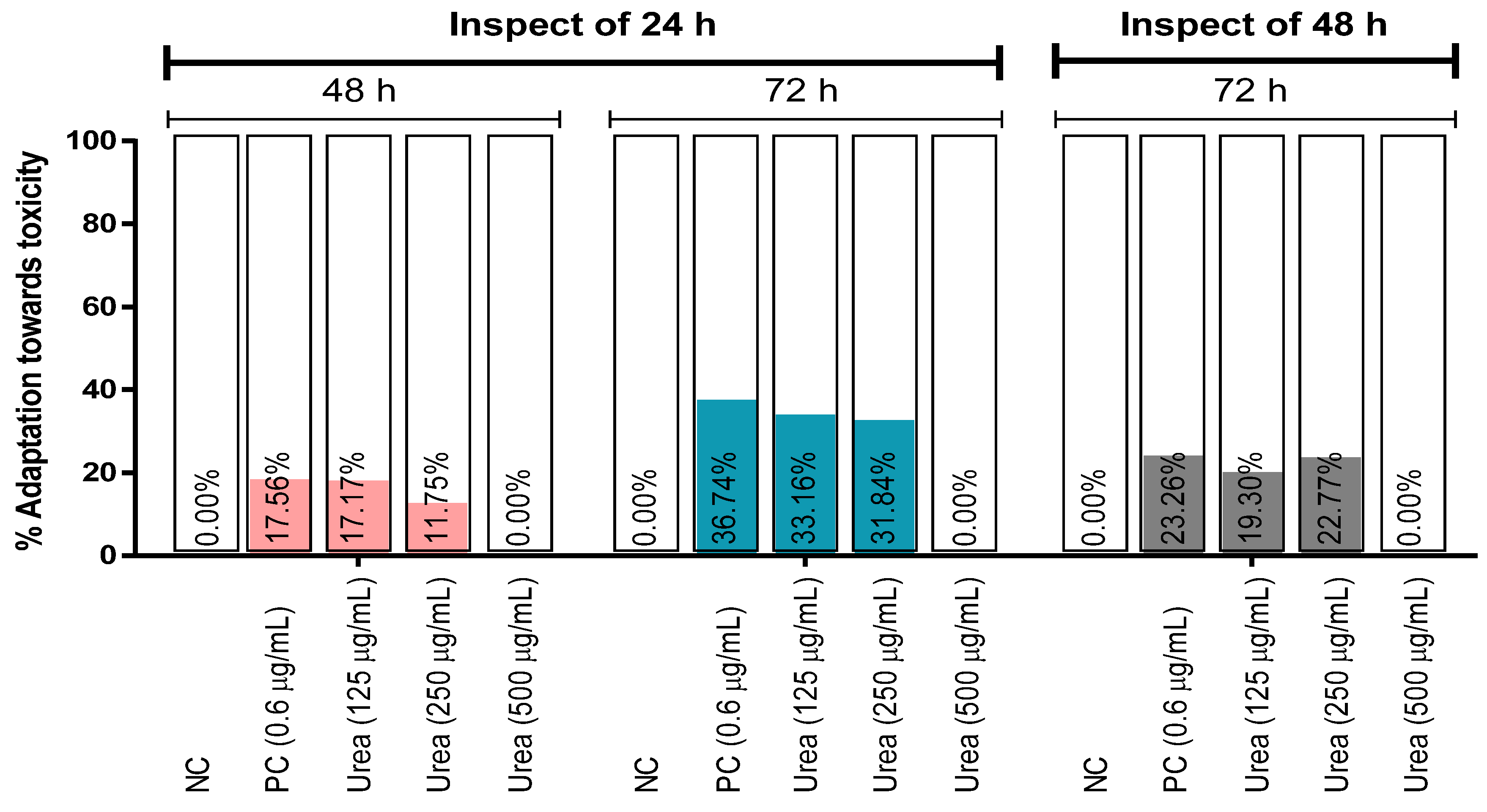Toxicity Analysis of Some Frequently Used Food Processing Chemicals Using Allium cepa Biomonitoring System
Simple Summary
Abstract
1. Introduction
2. Materials and Methods
2.1. Collection of Allium cepa, Test Samples, or Standard
2.2. Selection and Preparation of Test Concentrations
2.3. Study Protocol
2.4. Statistical Analysis
3. Results
4. Discussion
5. Conclusions
Author Contributions
Funding
Institutional Review Board Statement
Informed Consent Statement
Data Availability Statement
Acknowledgments
Conflicts of Interest
References
- Dorato, M.A.; Buckley, L.A. Toxicology testing in drug discovery and development. Curr. Protoc. Toxicol. 2007, 31, 19-1. [Google Scholar] [CrossRef] [PubMed]
- Gupta, R.; Polaka, S.; Rajpoot, K.; Tekade, M.; Sharma, M.C.; Tekade, R.K. Importance of toxicity testing in drug discovery and research. In Pharmacokinetics and Toxicokinetic Considerations; Academic Press: Cambridge, MA, USA, 2022; pp. 117–144. [Google Scholar]
- Feretti, D.; Zerbini, I.; Zani, C.; Ceretti, E.; Moretti, M.; Monarca, S. Allium cepa chromosome aberration and micronucleus tests applied to study genotoxicity of extracts from pesticide-treated vegetables and grapes. Food Addit. Contam. 2007, 24, 561–572. [Google Scholar] [CrossRef] [PubMed]
- Owolarafe, T.A.; Salawu, K.; Ihegboro, G.O.; Ononamadu, C.J.; Alhassan, A.J.; Wudil, A.M. Investigation of cytotoxicity potential of different extracts of Ziziphus mauritiana (Lam) leaf Allium cepa model. Toxicol. Rep. 2020, 7, 816–821. [Google Scholar] [CrossRef]
- Leme, D.M.; Marin-Morales, M.A. Allium cepa test in environmental monitoring: A review on its application. Mutat. Res./Rev. Mutat. Res. 2009, 682, 71–81. [Google Scholar] [CrossRef] [PubMed]
- Sambu, S.; Hemaram, U.; Murugan, R.; Alsofi, A.A. Toxicological and Teratogenic Effect of Various Food Additives: An Updated Review. Biomed Res. Int. 2022, 2022, 6829409. [Google Scholar] [CrossRef]
- Fahim, S.M.; Hossain, M.S.; Sen, S.; Das, S.; Hosssain, M.; Ahmed, T.; Rahman, S.M.M.; Rahman, M.K.; Alam, S. Nutrition and Food Security in Bangladesh: Achievements, Challenges, and Impact of the COVID-19 Pandemic. J. Infect. Dis. 2021, 224, S901–S909. [Google Scholar] [CrossRef]
- Ali, A.N.M.A. Food safety and public health issues in Bangladesh: A regulatory concern. Eur. Food Feed. Law Rev. 2013, 8, 31–40. [Google Scholar]
- Islam, R.; Mahmud, S.; Aziz, A.; Sarker, A.; Nasreen, M. A comparative study of present status of marketing of formalin treated fishes in six districts of Bangladesh. Food Nutr. Sci. 2015, 6, 124. [Google Scholar] [CrossRef]
- Wooster, G.A.; Martinez, C.M.; Bowser, P.R.; O’Hara, D.S. Human health risks associated with formalin treatments used in aquaculture: Initial study. North Am. J. Aquac. 2005, 67, 111–113. [Google Scholar] [CrossRef]
- Rashid, S. Sorbotro Sorbonasa Formaline (Everywhere, the dangerous formalin). Dly. Janakantha 2007, 9, 1–2. [Google Scholar]
- Yeasmin, T.; Reza, M.S.; Khan, M.N.A.; Shikha, F.H.; Kamal, M. Present status of marketing of formalin treated fishes in domestic markets at Mymensingh district in Bangladesh. Int. J. Biol. Res. 2010, 1, 21–24. [Google Scholar]
- Meghla, Y.T. Quantitative Analysis of Artificial Sweeteners in Soft Drink Samples. Doctoral Dissertation, BRAC University, Dhaka, Bangladesh, 2018. [Google Scholar]
- Bian, X.; Tu, P.; Chi, L.; Gao, B.; Ru, H.; Lu, K. Saccharin induced liver inflammation in mice by altering the gut microbiota and its metabolic functions. Food Chem. Toxicol. 2017, 107, 530–539. [Google Scholar] [CrossRef] [PubMed]
- Bansal, N. Prediabetes diagnosis and treatment: A review. World J. Diabetes 2015, 6, 296. [Google Scholar] [CrossRef]
- Suez, J.; Korem, T.; Zeevi, D.; Zilberman-Schapira, G.; Thaiss, C.A.; Maza, O.; Israeli, D.; Zmora, N.; Gilad, S.; Weinberger, A.; et al. Artificial sweeteners induce glucose intolerance by altering the gut microbiota. Nature 2014, 514, 181–186. [Google Scholar] [CrossRef] [PubMed]
- Arnold, D.L.; Krewski, D.; Munro, I.C. Saccharin: A toxicological and historical perspective. Toxicology 1983, 27, 179–256. [Google Scholar] [CrossRef] [PubMed]
- Witte, C.P. Urea metabolism in plants. Plant Sci. 2011, 180, 431–438. [Google Scholar] [CrossRef] [PubMed]
- Matsumoto, S.; Haberle, J.; Kido, J.; Mitsubuchi, H.; Endo, F.; Nakamura, K. Urea cycle disorders—Update. J. Hum. Genet. 2019, 64, 833–847. [Google Scholar] [CrossRef] [PubMed]
- Shahzad, M.N.; Javed, M.T.; Shabir, S.; Irfan, M.; Hussain, R. Effects of feeding urea and copper sulphate in different combinations on live body weight, carcass weight, percent weight to body weight of different organs and histopathological tissue changes in broilers. Exp. Toxicol. Pathol. 2012, 64, 141–147. [Google Scholar] [CrossRef] [PubMed]
- Leme, D.M.; De Angelis, D.D.F.; Marin-Morales, M.A. Action mechanisms of petroleum hydrocarbons present in waters impacted by an oil spill on the genetic material of Allium cepa root cells. Aquat. Toxicol. 2008, 88, 214–219. [Google Scholar] [CrossRef]
- Russel, P.J. Chromosomal mutation. Genetics 2002, 595–621. [Google Scholar]
- Albertini, R.J.; Anderson, D.; Douglas, G.R.; Hagmar, L.; Hemminki, K.; Merlo, F.; Natarajan, A.T.; Norppa, H.; Shuker, D.E.; Tice, R.; et al. IPCS guidelines for the monitoring of genotoxic effects of carcinogens in humans. Mutat. Res./Rev. Mutat. Res. 2000, 463, 111–172. [Google Scholar] [CrossRef] [PubMed]
- Fernandes, T.C.; Mazzeo, D.E.C.; Marin-Morales, M.A. Mechanism of micronuclei formation in polyploidizated cells of Allium cepa exposed to trifluralin herbicide. Pestic. Biochem. Physiol. 2007, 88, 252–259. [Google Scholar] [CrossRef]
- Fiskesjo, G. The Allium test as a standard in environmental monitoring. Hereditas 1985, 102, 99–112. [Google Scholar] [CrossRef] [PubMed]
- Adeyemo, O.A.; Farinmade, A.E. Genotoxic and cytotoxic effects of food flavor enhancer, monosodium glutamate (MSG) using Allium cepa assay. Afr. J. Biotechnol. 2013, 12, 1459–1466. [Google Scholar]
- Barberrio, A.; Voltolini, J.C.; Mello, M.L.S. Standartization of bulb and root sample sizes for the Allium test. Ecotoxicology 2011, 20, 927. [Google Scholar] [CrossRef]
- Fusconi, A.; Repetto, O.; Bona, E.; Massa, N.; Gallo, C.; Dumas-Gaudot, E.; Berta, G. Effects of cadmium on meristem activity and nucleus ploidy in roots of Pisum sativum L. cv. Frisson seedlings. Environ. Exp. Bot. 2006, 58, 253–260. [Google Scholar] [CrossRef]
- Webster, P.L.; MacLeod, R.D. The root apical meristem and its margin. In Plant Roots. The Hidden Half, 2nd ed.; Marcel Dekker: New York, NY, USA, 1996; pp. 51–76. [Google Scholar]
- Seth, C.S.; Chaturvedi, P.K.; Misra, V. Toxic effect of arsenate and cadmium alone and in combination on giant duckweed (Spirodela polyrrhiza L.) in response to its accumulation. Environ. Toxicol. Int. J. 2007, 22, 539–549. [Google Scholar] [CrossRef] [PubMed]
- Miller, M.A.; Zachary, J.F. Mechanisms and morphology of cellular injury, adaptation, and death. In Pathologic Basis of Veterinary Disease; Mosby: Maryland Heights, MO, USA, 2017; pp. 2–43.e19. [Google Scholar]
- Epstein, E.; Bloom, A.J. Mineral Nutrition of Plants: Principles and Perspectives, 2nd ed.; Sinauer Associates: Sunderland, UK, 2005. [Google Scholar]
- Gulser, F. Effects of ammonium sulphate and urea on NO3− and NO2− accumulation, nutrient contents and yield criteria in spinach. Sci. Hortic. 2005, 106, 330–340. [Google Scholar] [CrossRef]
- Achary, V.M.M.; Panda, B.B. Aluminium-induced DNA damage and adaptive response to genotoxic stress in plant cells are mediated through reactive oxygen intermediates. Mutagenesis 2010, 25, 201–209. [Google Scholar] [CrossRef]
- Panda, B.B.; Achary, V.M.M. Mitogen-activated protein kinase signal transduction and DNA repair network are involved in aluminum-induced DNA damage and adaptive response in root cells of Allium cepa L. Front. Plant Sci. 2014, 5, 256. [Google Scholar] [CrossRef]
- Rabik, C.A.; Dolan, M.E. Molecular mechanisms of resistance and toxicity associated with platinating agents. Cancer Treat. Rev. 2007, 33, 9–23. [Google Scholar] [CrossRef] [PubMed]
- Rozman, K.K.; Doull, J. Dose and Time as Variables of Toxicity. Toxicology 2000, 144, 169–178. [Google Scholar] [CrossRef] [PubMed]
- Braga, A.L.; de Meneses, A.A.; Santos, J.V.O.; dos Reis, A.C.; de Lima, R.M.T.; da Mata, A.M.O.F.; Paz, M.F.C.J.; Alves, L.B.S.; Shaw, S.; Uddin, S.J.; et al. Toxicogenetic Study of Omeprazole and the Modulatory Effects of Retinol Palmitate and Ascorbic Acid on Allium cepa. Chemosphere 2018, 204, 220–226. [Google Scholar] [CrossRef] [PubMed]
- Braga, A.L.; do Nascimento, P.B.; Paz, M.F.C.J.; de Lima, R.M.T.; Santos, J.V.O.; de Alencar, M.V.O.B.; de Meneses, A.-A.P.M.; Gomes Júnior, A.L.; Islam, M.T.; e Sousa, J.M.C.; et al. Anti-oxidative Defense against Omeprazole-induced Toxicogenetical Effects in Swiss Mice. Pharmacol. Rep. 2021, 73, 551–562. [Google Scholar] [CrossRef]
- Paz, M.F.C.J.; de Alencar, M.V.O.B.; de Lima, R.M.P.; Sobral, A.L.P.; do Nascimento, G.T.M.; dos Reis, C.A.; Coêlho, M.d.P.S.d.S.; do Nascimento, M.L.L.B.; Gomes Júnior, A.L.; Machado, K.d.C. Pharmacological Effects and Toxicogenetic Impacts of Omeprazole: Genomic Instability and Cancer. Oxidative Med. Cell. Longev. 2020, 2020, 3457890. [Google Scholar] [CrossRef]
- Da Mata, A.M.P.F.; Paz, M.F.C.J.; de Menezes, A.-A.P.M.; dos Reis, A.C.; Souza, B.S.; Sousa, C.D.C.; Machado, S.A.; Medeiros, T.S.G.; Sarkar, C.; Islam, M.T.; et al. Evaluation of Mutagenesis, Necrosis and Apoptosis Induced by Omeprazole in Stomach Cells of Patients with Gastritis. Cancer Cell Int. 2022, 22, 154. [Google Scholar] [CrossRef]



| Treatments | Root Length (mm) | % Inhibition of RG | IC50 (µg/mL) [CI (µg/mL); R2] | |||||||
|---|---|---|---|---|---|---|---|---|---|---|
| 24 h | 48 h | 72 h | 24 h | 48 h | 72 h | 24 h | 48 h | 72 h | ||
| NC | 117.80 ± 6.01 | 185.20 ± 6.19 | 262.20 ± 3.45 | - | - | - | - | - | - | |
| PC | 50.00 ± 2.83 * | 64.80 ± 4.92 * | 70.40 ± 0.97 * | 57.55 | 65.01 | 73.15 | - | - | - | |
| Formalin (µg/mL) | 0.10 | 231.25 ± 4.79 | 259.25 ± 7.01 | 307.00 ± 4.45 | - | - | - | 0.33 ± 0.12 [0.01–10.10; 0.86] | 0.40 ± 0.04 [0.12–1.29; 0.98] | 0.34 ± 0.08 [0.03–4.11; 0.92] |
| 0.20 | 142.00 ± 5.05 | 207.00 ± 5.14 | 211.00 ± 3.68 * | - | - | 19.527 | ||||
| 0.40 | 105.00 ± 4.45 * | 132.00 ± 4.92 * | 144.00 ± 3.50 * | 10.86 | 28.72 | 45.08 | ||||
| Treatments | Root Length (mm) | % Inhibition of RG | IC50 [CI; R2] | |||||||
|---|---|---|---|---|---|---|---|---|---|---|
| 24 h | 48 h | 72 h | 24 h | 48 h | 72 h | 24 h | 48 h | 72 h | ||
| NC | 117.80 ± 6.01 | 185.20 ± 6.19 | 262.20 ± 3.45 | - | - | - | - | - | - | |
| PC | 50.00 ± 2.83 * | 64.80 ± 4.92 * | 70.40 ± 0.97 * | 57.55 | 65.01 | 73.15 | - | - | - | |
| Saccharin µg/mL | 05 | 171.25 ± 5.80 | 267.00 ± 4.29 | 281.75 ± 1.36 | - | - | - | 33.87 ± 0.16 [0.31–3728; 0.89] | 34.60 ± 0.15 [0.44–2712; 0.91] | 34.32 ± 0.08 [3.10–379.8; 0.97] |
| 15 | 120.75 ± 5.19 | 192.75 ± 4.60 | 219.00 ± 2.71 * | - | - | 16.47 | ||||
| 25 | 109.25 ± 3.95 * | 171.75 ± 5.40 * | 181.25 ± 6.71 * | 7.26 | 7.26 | 30.87 | ||||
| Treatments | Root Length (mm) | % Inhibition of RG | IC50 [CI; R2] | |||||||
|---|---|---|---|---|---|---|---|---|---|---|
| 24 h | 48 h | 72 h | 24 h | 48 h | 72 h | 24 h | 48 h | 72 h | ||
| NC | 117.80 ± 6.01 | 185.20 ± 6.19 | 262.20 ± 3.45 | - | - | - | - | - | - | |
| PC | 50.00 ± 2.83 * | 64.80 ± 4.92 * | 70.40 ± 0.97 * | 57.55 | 65.01 | 73.15 | - | - | - | |
| Urea (µg/mL) | 125 | 182.00 ± 7.86 | 237.00 ± 7.87 | 270.75 ± 8.18 | - | - | - | 848.10 ± 0.0 [230.20–3124; 0.99] | 190.10 ± 0.20 [0.62–61600; 0.68] | 267.90 ± 0.16 [2.61–27556; 0.73] |
| 250 | 169.75 ± 7.41 | 235.50 ± 9.94 | 257.50 ± 5.59 * | - | - | 1.79 | ||||
| 500 | 139.50 ± 7.03 | 198.25 ± 4.43 | 234.50 ± 8.24 * | - | - | 10.56 | ||||
Disclaimer/Publisher’s Note: The statements, opinions and data contained in all publications are solely those of the individual author(s) and contributor(s) and not of MDPI and/or the editor(s). MDPI and/or the editor(s) disclaim responsibility for any injury to people or property resulting from any ideas, methods, instructions or products referred to in the content. |
© 2023 by the authors. Licensee MDPI, Basel, Switzerland. This article is an open access article distributed under the terms and conditions of the Creative Commons Attribution (CC BY) license (https://creativecommons.org/licenses/by/4.0/).
Share and Cite
Bhuia, M.S.; Siam, M.S.H.; Ahamed, M.R.; Roy, U.K.; Hossain, M.I.; Rokonuzzman, M.; Islam, T.; Sharafat, R.; Bappi, M.H.; Mia, M.N.; et al. Toxicity Analysis of Some Frequently Used Food Processing Chemicals Using Allium cepa Biomonitoring System. Biology 2023, 12, 637. https://doi.org/10.3390/biology12050637
Bhuia MS, Siam MSH, Ahamed MR, Roy UK, Hossain MI, Rokonuzzman M, Islam T, Sharafat R, Bappi MH, Mia MN, et al. Toxicity Analysis of Some Frequently Used Food Processing Chemicals Using Allium cepa Biomonitoring System. Biology. 2023; 12(5):637. https://doi.org/10.3390/biology12050637
Chicago/Turabian StyleBhuia, Md. Shimul, Md. Sajjad Hossain Siam, Md. Riat Ahamed, Uttam Kumar Roy, Md. Imran Hossain, Md. Rokonuzzman, Tawhida Islam, Rezoan Sharafat, Mehedi Hasan Bappi, Md. Nayem Mia, and et al. 2023. "Toxicity Analysis of Some Frequently Used Food Processing Chemicals Using Allium cepa Biomonitoring System" Biology 12, no. 5: 637. https://doi.org/10.3390/biology12050637
APA StyleBhuia, M. S., Siam, M. S. H., Ahamed, M. R., Roy, U. K., Hossain, M. I., Rokonuzzman, M., Islam, T., Sharafat, R., Bappi, M. H., Mia, M. N., Emamuzzaman, M., de Almeida, R. S., Coutinho, H. D. M., Raposo, A., Alturki, H. A., & Islam, M. T. (2023). Toxicity Analysis of Some Frequently Used Food Processing Chemicals Using Allium cepa Biomonitoring System. Biology, 12(5), 637. https://doi.org/10.3390/biology12050637











